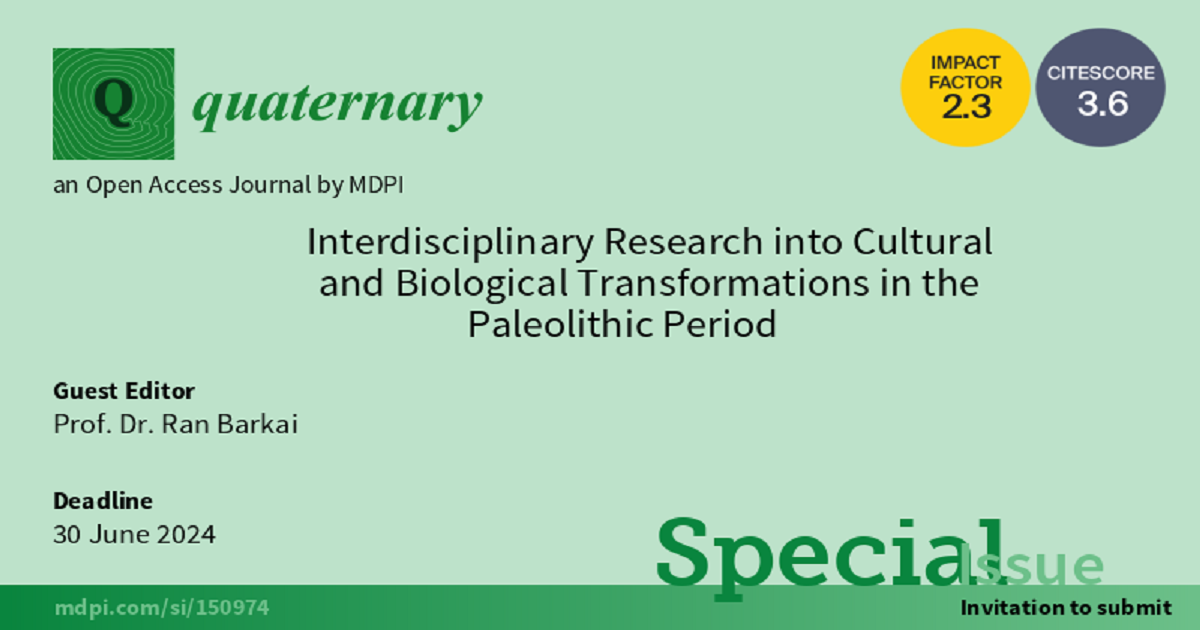Interdisciplinary Research into Cultural and Biological Transformations in the Paleolithic Period
A special issue of Quaternary (ISSN 2571-550X).
Deadline for manuscript submissions: 30 June 2024 | Viewed by 29245

Special Issue Editor
Interests: lower palaeolithic; acheulean; handaxes; elephants; diet; cosmology and ontology; lithic technology; caves; cultural evolution
Special Issue Information
Dear Colleagues,
The incredibly long Paleolithic period is still considered by some as a stagnant phase in human cultural and biological evolution prior to the appearance of our direct ancestors. However, extensive interdisciplinary research in recent years has clearly demonstrated that this is not the case. Starting from the earliest stages of human presence on the planet some three million years ago, an impressive series of transformations, innovations, modifications and adaptations characterise our lineage. These changes in behaviour and culture took place alongside biological adaptations in human physical properties; faunal turnovers and extinctions as well as climatic fluctuations. This makes the Old Stone Age a hectic, dynamic and lively epoch worthy of investigation both in the diachronic and synchronic levels, in order to decipher the nature of transformations that characterize the emergence, prosperity and legacy of our lineage.
This Special Issue, “Interdisciplinary Research into Cultural and Biological Transformations in the Paleolithic Period”, aims to present the state-of-the-art as well as outside of the box studies regarding changes in human adaptation; human physiology; faunal diversity; climatic fluctuations as well as the possible nexus between these lines of inquiry. We especially seek innovative and provocative thinking related to, but not limited to: the emergence and disappearance of lithic technologies; the emergence and disappearance of human species and physical characteristics; turnovers and extinctions of prey animals; transformations in human diet and trophic levels; changes in burial practices and symbolic expressions, and so on and so forth. No chronological nor geographical boundaries are set, as long as the Lower, Middle, Upper and Epi Paleolithic periods are concerned. Particular case studies as well as more comprehensive overviews are welcomed.
Prof. Dr. Ran Barkai
Guest Editor
Manuscript Submission Information
Manuscripts should be submitted online at www.mdpi.com by registering and logging in to this website. Once you are registered, click here to go to the submission form. Manuscripts can be submitted until the deadline. All submissions that pass pre-check are peer-reviewed. Accepted papers will be published continuously in the journal (as soon as accepted) and will be listed together on the special issue website. Research articles, review articles as well as short communications are invited. For planned papers, a title and short abstract (about 100 words) can be sent to the Editorial Office for announcement on this website.
Submitted manuscripts should not have been published previously, nor be under consideration for publication elsewhere (except conference proceedings papers). All manuscripts are thoroughly refereed through a single-blind peer-review process. A guide for authors and other relevant information for submission of manuscripts is available on the Instructions for Authors page. Quaternary is an international peer-reviewed open access quarterly journal published by MDPI.
Please visit the Instructions for Authors page before submitting a manuscript. The Article Processing Charge (APC) for publication in this open access journal is 1600 CHF (Swiss Francs). Submitted papers should be well formatted and use good English. Authors may use MDPI's English editing service prior to publication or during author revisions.





